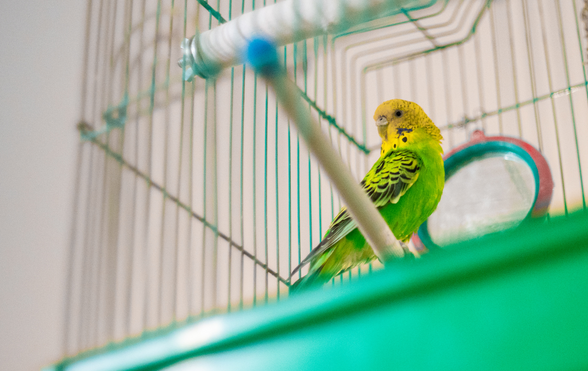Training your parrot to step into a carrier is important as occasions will arise when your parrot needs transporting to the vet, you’re taking her on holiday or she needs transporting for other reasons. Find out the best way to train your parrot…..
Is your parrot insured? Get a quote for up to £5,000 of vet fees, death and theft cover | We’ve been insuring exotic pets since 1996 | Check out our customer reviews on Feefo.
Ten years ago, I was fortunate to attend a training workshop for companion bird handlers in Florida at Natural Encounters Inc (NEI), parrot expert Steve Martin’s home base.
The bird I chose to train to step into a carrier was a 12 month-old hand reared Blue Fronted Amazon. He had no name yet. There was a 9 on his leg band so I called him Niney.
I believe Niney taught me as much as I taught him. For my team mate, Phyllis Taylor and myself, our team leader was the charismatic but rigorous young Australian trainer, Nic Bishop.
Skip to content: Advanced planning when training | Training plan for teaching your parrot | Putting the training plan into action | Record keeping | Positive and negative reinforcement | Food management | Avoid chatting | Avoid aversive behaviour | Parrot training mistakes | Training my parrot Perdy
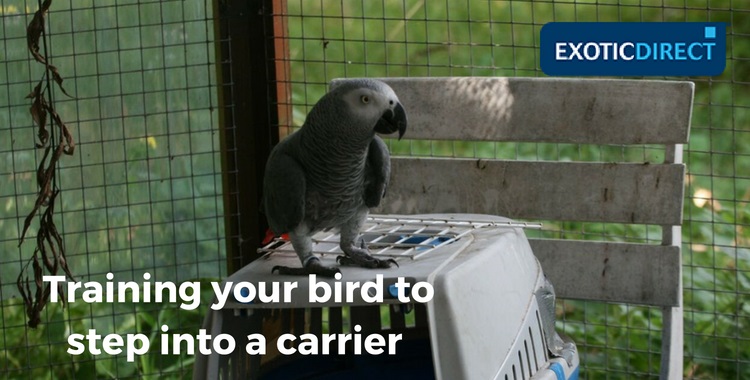 My African Grey was trained to step up into a carrier before I brought her home
My African Grey was trained to step up into a carrier before I brought her home
Advanced planning when training a parrot
Niney was the first novice bird that I trained from scratch. My two African Greys and Perdy LSC Cockatoo were already trained to step up and enter a carrier before I got them. But Perdy later desisted.
The conditions for successful parrot training were planned in advance:
- The training environment must be suitable for the particular bird – that is enough space and no distractions.
- The bird’s diet is regulated so that he wants to comply to obtain the reward, in Niney’s case a slice of peanut.
Some of the struts were removed from one side of the carrier so that I could poke my fingers through the strut and the bird could see the proffered treat from outside the carrier.
That provides his motivation to hop in get the treat and hop out. With very nervous birds another strategy is to remove the top of the carrier until they gain confidence.
Phyliss and I were allocated a training tent about 10 metres square for our 2 x 30-minute-long sessions. The tent contained two perches and a carrier placed on a table.
The advantage of the space was that the novice bird wasn’t crowded. The tent was staffed by Nic Bishop the trainer and Phyliss Taylor and myself – the students.
Is your parrot insured? Get a quote for up to £5,000 of vet fees, death and theft cover | We’ve been insuring exotic pets since 1996 | Check out our customer reviews on Feefo.
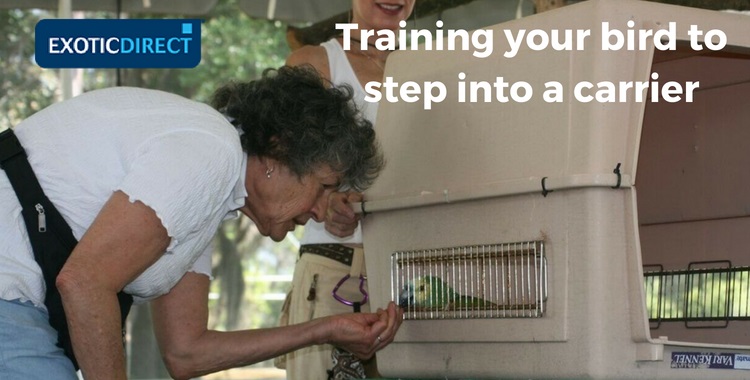 Follow a training plan to teach your parrot to enter a carrier – and reward her at each step
Follow a training plan to teach your parrot to enter a carrier – and reward her at each step
Training plan for teaching your bird to step into a carrier
The following training plan was mine for teaching Niney to enter a carrier:
- Establish the bird’s comfort and willingness to step up
- Desensitise the parrot to the sight of the carrier on the table
- Reward the parrot for any movement (even a glance) towards the carrier
- Put a treat just outside the open carrier
- Establish a cue for the parrot to step up to the carrier and eat the treat
- With gradual repetitions move the treat further back until the bird must step right in to take the treat
- Bird steps into the carrier
- Trainer closes the door
- Trainer opens the door immediately if the bird turns its head
- Bird stays in the carrier with the door closed
- Carrier lifted and then carrier lowered
- Bird steps out of the carrier and steps back on the trainers hand for another treat
Do not hurry the steps. The bird should remain calm throughout and if the bird shows the slightest discomfort, go back a stage.
Time for the steps can vary from a couple of days to a week or more
Not sure what to feed your parrot? Check out What your parrot can eat – parrot food and diet ideas
Putting the parrot training plan into action
Day one: I was surprised how quickly Niney got used to me. By the end of day one, he’d step up to my hand. It was comparatively easy to ask him to step onto the table where the carrier stood. The training advanced fast; I was surprised and delighted.
Days two to five: Niney would fly to me and step into the carrier. Once he was inside, Nic was able to shut the grille.
Niney went on eating bits of peanuts that I was shoving through the gap in the struts. However, if he even glanced at the shut carrier door, I had to swing it back open.
There is sound theory behind this. The trainee bird is being given choice. If he is really scared of the carrier, he does not have to stay in it. If the shut door worries him, it will be immediately opened.
Niney would glance at the shut door. It opened straightaway. He went on eating nuts. There is no coercion.
A common mistake is slamming the door shut and rushing into the car. And usually this means the next time you ask for a carrier entrance the bird will fly away. And with clipped birds, she may even bite.
At NEI no birds are ever clipped. No reputed trainer nowadays advocates that unnecessary practice.
Day six: The twelve steps were all carried through in five days and on the final day all students presented the behaviours we had practised.
For the final demonstration, Niney stood nicely on his perch. I asked, ‘fly to me’. Niney flew to my hand. I walked to the table where the open carrier stood. Niney hopped down and walked into the carrier.
For the last six days every time he had done so, something good happened so he had no fear.
I closed the grille and Nic the trainer and Phyliss my partner lifted and carried the carrier a few metres. It was put down and opened. Niney walked out, flew to me and was rewarded with a whole peanut.
I flew back to UK full of firm intentions to retrain Perdy, aged five, to relearn to trust me and to enter a carrier again.
Check out How to train your parrot to step up
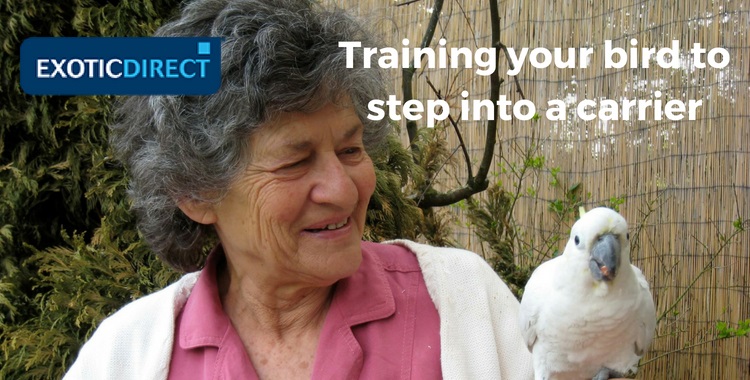 Teaching Perdy the parrot to step into a carrier wasn’t as easy as teaching Niney
Teaching Perdy the parrot to step into a carrier wasn’t as easy as teaching Niney
Parrot training record keeping is essential
At NEI, we were taught accurate, precise note taking. I realised how invaluable record keeping is for training at any level. For your own work at home, an accurate record of daily sessions makes life so much easier.
One of the methods of professional trainers is the daily weighing of a bird in training. For that you need an accurate scale and naturally a bird that will step up and perch on demand.
A training sheet tells you the bird’s name and the target behaviour required. Then you fill in columns: Date, Weight, Diet and Comments.
The benefits of this are enormous. For me I could see what progress we were or were not making and future training becomes faster. Also of course in an establishment, if another trainer takes on the bird, it is clear what has been happening.
Positive and negative reinforcement in parrot training
Positive reinforcement: This creates a trusting relationship with your parrot. Positive reinforcement training works with the understanding that we all (parrots included!) respond better to praise than punishment.
Positive reinforcement entails giving your parrot something she wants immediately after she does a behaviour you’ve requested. That reward makes her more likely to repeat the behaviour in the future. Positive reinforcement training is a powerful tool for changing your parrot’s actions.
Negative reinforcement: The other side of PR methods are negative reinforcement. The parrot is placed in a situation where it will react in order to avoid something unpleasant.
Control and punishment were favoured methods to impose discipline on most of us in our youth. Negative reinforcement techniques can range from the mild – like covering the bird to the extreme – shouting or squirting with water.
The short term benefits of negative reinforcement are usually cancelled out by the long term ones, a bird may become fearful, apathetic or even more aggressive.
Time out: This is the only punishment that is favoured by good trainers. Known as Negative Punishment, you stop giving the parrot the opportunity to gain the reward. Time outs vary from a few seconds to a few minutes or even later the same day.
In a brief summary, Negative Punishment is when something the parrot wants is taken away as a result of an undesired action.
You may like this: How to train a bird using positive reinforcement
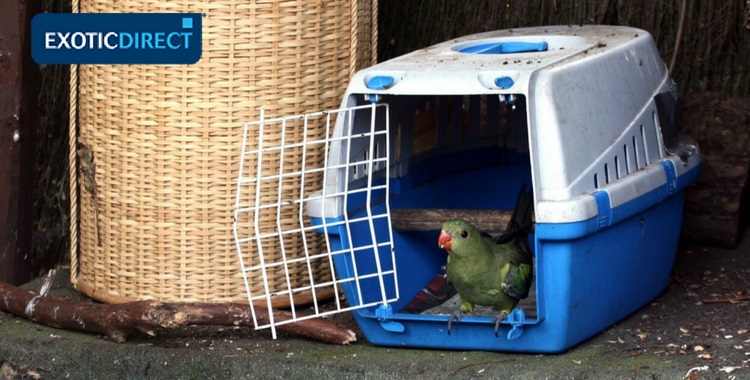 Keet a Rockpebbler watched and learned from Perdy, and quickly learnt to step into a carrier.
Keet a Rockpebbler watched and learned from Perdy, and quickly learnt to step into a carrier.
Food management in parrot training
At NEI, if a parrot being trained hasn’t earned all his nuts and seeds during training sessions, the amount left over is given to them for their last feed.
By weighing daily, Nic the trainer could raise or lower the amount of the favourite, richer items. After one session when Niney had responded less well than the previous day, Nic gave him less goodies that night. Next morning, Niney was eager to earn the yummy treats.
This strategy works with daily weighing. Once, I got home I found daily weighing did not suit my life style and reverted to weekly weighing.
Give your parrot choice during its training
Offering your parrot choice is another core concept behind positive reinforcement methods. Choice underlies any scheme of training a behaviour using positive reinforcement methods.
By never coercing, alarming or going too fast, the parrot learns to trust you. To strive your best to develop trust between you and your bird is possibly the most valuable interaction that you can hope for.
Although Niney was a novice bird, he’d been hand fed and had no negative baggage through a handler’s hasty or ill-judged actions. It was a vindication of these methods that Niney, when he grew uncomfortable, would fly to me during the training session. A sign that he had developed trust in me.
Avoid chattering to the parrot when training
The professional trainers admonished us for continually talking to the parrots with whom we were working. Rob Bules, senior trainer told me, as I chattered nervously to a palm cockatoo that I was taking from a carrier to a training session. ‘It’s simply white noise to a bird.’
At the time, I was not convinced but with the passage of time, I’m sure that Rob was right. Chatter can reassure us; to the bird it’s meaningless. Ask for the behaviour, give the bridge which may be a clicker of a word ‘good.’ reward with a treat or a toy, congratulate if you wish but don’t chatter.
Avoid aversive behaviour in training
At home, I asked for step up by pushing the flat of my hand against the parrot’s chest. This is common practice in UK. Nic Bishop explained that it was an aversive – not the best method.
The method Nic taught me , which I’ve used subsequently when training a young bird or trying to eradicate a bad habit in an older bird is this:
The bird stands on a perch or a flat surface. I invite the bird to step onto my left hand which is held palm open. In my right hand I hold a treat. When the bird can see the treat the practice is called baiting or luring. This is how I started off with Niney.
A more advanced technique is to close the treat in your right hand. This has a twofold positive motivation. First the parrot is encouraged to concentrate on what he is being asked to perform and secondly, he will be curious as to which goodie is closed in the handler’s fist.
Mistakes you can make when training a parrot to enter a carrier
There are some common mistakes that people make when training their parrots. Here are a few of them:
- Training in a bad mood
- Grabbing the bird
- Towelling the bird
- Netting the bird
- Shouting at the bird
- Shutting the carrier door before the bird is fully comfortable with being in there. This could promote a feeling of distrust and lack of choice in the bird.
The exception to points above arise when dealing with untamed, aviary birds. Then netting is the safest, quickest method of securing the bird.
It’s a harmful habit to use on tame pet birds. A pet bird on seeing a towel or a net and not having been desensitised to it can slip into panic mode. A clipped bird may bite; a flighted bird will fly away.
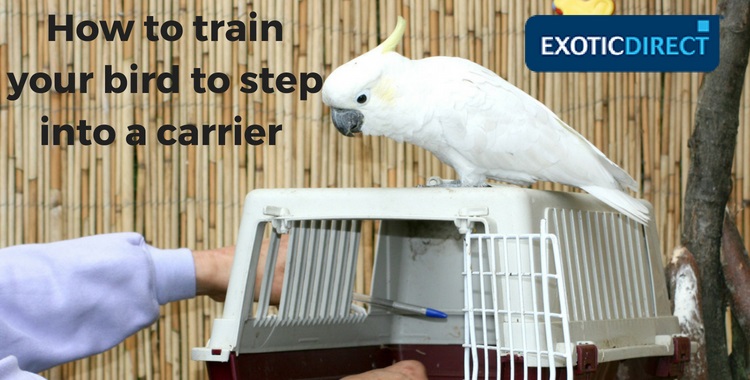 Training Perdy to step into a carrier
Training Perdy to step into a carrier
Training Perdy my Lesser Sulphur Crested cockatoo to step into a carrier
Once back home, I hoped to get Perdy to walk into a carrier in 10 days instead of six. In total it took 17 days. I worked out a plan similar to the one with Niney.
When Perdy first came here at one year old, she’d step up and enter a carrier. I made some mistakes handling her later on and Perdy showed unwillingness to fly to me, step up for me or walk into a carrier.
I worked hard on this problem for five months. By the time I went to the NEI workshop in Florida, Perdy had regained some trust in me but it certainly wasn’t fool proof. She no longer flew to me willingly.
- I put Perdy in a 6 x 5 metres, closed-off section of my aviary. In one corner, I placed table and a carrier. I fed her two bowls of food a day. It took five days before she‘d fly to my hand for a nut. I went at her pace.
- So, carrier training started later than planned. However, by the end of day one, she’d popped her head into the carrier and taken an almond. Of course, she’d already had five days to get used to the sight of it.
- On day seven Perdy was ready to walk into the carrier and out again. She repeated the action five times for the reward of a sliver of almond. This nut I’d found out was her favourite.
Parrots, if not frightened, enjoy training, a sign of their intelligence. As the days progressed, Perdy flew far more readily to me than previously.
- Perdy accepted flying to me and walking into the carrier within a few days. There was no question of shutting the grille. However after a few repetitions, she lost interest. After a dozen sunflower seeds and several almonds, she grew bored of walking in and out of the carrier and flew off.
A positive spin off from Perdy’s carrier training was that other parrots were watching. A couple of hand fed Rockpebblers were in the aviary section with her. One of them, Keet, watched assiduously. After Perdy’s training had finished, Keet learned to fly into the crarrier after only a few sessions.
- You must be resourceful and flexible with any training methods. Perdy found out I kept the treats in a pouch round my waist as I’d done at NEI.
So instead of entering the carrier, she’d fly down to my waist, help herself to a nut and fly off. I outwitted her by swivelling the pouch behind me and leaning against an aviary support.
After fifteen days, I hadn’t achieved the same result as I had with Niney after only six. Before I grew discouraged, we had a marvellous breakthrough.
- Wal, my husband, Perdy’s favoured person, came into the aviary during one of our sessions. On this occasion, Perdy flew from Wal to me. And as I gave the cue ‘enter carrier’, she complied immediately, and I even shut the door for a second.
Was she showing off her new accomplishments to Wal? The latest research tells us that birds have more self-awareness than was formerly believed. Only Perdy knows the answer.
- On day 17 for the first time I lifted the carrier, carried it a couple of metres, replaced it on the table and opened it. She’d been in it for maybe 30 seconds. As soon as I opened she flew off. But – and this but is crucial – when I repeated the carrier cue, she complied. She got a whole almond poked through the strut.
Then she did something unusual. She flew to the training perch and started offering all the trick behaviours she knew – the wave, the bow, the turn around. She raised her crest and whispered ‘Hi, Perdy’ in her soft, sweet, typical cockatoo voice.
When not screaming, most cockatoos have the gentlest of voices. I’d been taught not to reward unasked for behaviours. But Perdy was being trained to enter a bird show, so she got a reward anyway.
The carrier training wasn’t throwing up problems but not a total success because if she wasn’t peckish, Perdy showed no interest in entering a carrier. I had to think of something that would make the carrier irresistible.
Is your parrot a screamer? Check out Why is my parrot screaming?
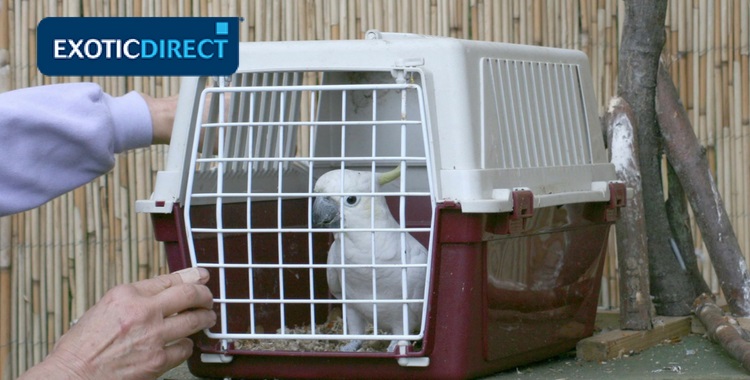 Perdy the cockatoo steps into the carrier and Dot closes the door. Success!
Perdy the cockatoo steps into the carrier and Dot closes the door. Success!
Lateral thinking when parrot training
The solution, when food isn’t the main motivator, is to find another reward that your parrot really wants.
Perdy is a Biro fanatic. She’ll grab a Biro and chew it to bits. When food is not the desired reward find another, praise, scratches, or access to a favourite toy often work for pet birds.
Perdy loved chewing Biros. (Note: not every handler would agree with letting a parrot chew a Biro.) So, I bought a handful to use in carrier training.
Perdy watched me, head on one side as I tied a Biro to the struts inside the carrier. She flew to the top of the carrier, leaned over and pulled the Biro through the gap and flew off. She was so clever! I was cleverer though and blocked the gaps in the struts.
Thus, unless she went into the carrier, she couldn’t get the Biro and since I had tied it with several knots, she did not mind the carrier door closed while she bit through the knots.
Parrot training tips
- Create a workable plan
- Use positive reinforcement
- Be patient
- Be flexible because your bird may not react exactly as another one would. Perdy compared to Niney are prime examples.
The training should be successful and within a few weeks your parrot should walk into her carrier and not become upset when the grille is shut.
Is your parrot insured? Get a quote for up to £5,000 of vet fees, death and theft cover | We’ve been insuring exotic pets since 1996 | Check out our customer reviews on Feefo.
Additional learning resources
When I did my course at NEI, all students attended lectures by Steve Martin and Dr. Susan Friedman. Not everyone can get to Florida or Susan Friedman’s public lectures but both of these celebrated trainers provide extensive websites where any parrot handler can read their articles. I’d also highly recommend Barbara Heidenreich’s website which is free to peruse or her webinars which have a joining fee.
Disclaimer: This article has been written by Dorothy Schwarz, and the opinions and training methods used are hers. ExoticDirect do not accept any liability should you choose to try any of the training methods.

